March 12, 2025
How to Set up a PTO Tracker in Google Sheets (2025 Template)
A Google Sheets PTO tracker is a simple, inexpensive way to track annual leave, sick leave and other absences...
In this article, we’re going to do a deep dive into the best remote working tools on the market in 2024.
For all its benefits, there are some struggles that come with remote work, and remote work software helps overcome these struggles. If you’re working from home, or you’re running a remote team, choosing the right tools is essential to maintain optimal productivity.
Read on to learn more about remote work tools that can help you, or your business, be more productive away from the office.
We’ve collated a huge list of software tools that help remote workers be more productive, and help remote teams work together and collaborate better.
This is on the back of our experience working as a fully remote team for more than 10 years. We’ve built several successful businesses from the ground up, without an office, and have used a lot these tools in all our own businesses.
The list is broken down into ten categories, with 37 amazing tools altogether. Here’s a first glance of every remote working tool mentioned in this post:
Now let’s break down these tools, and the different types of remote work tools you should be using, in more detail.
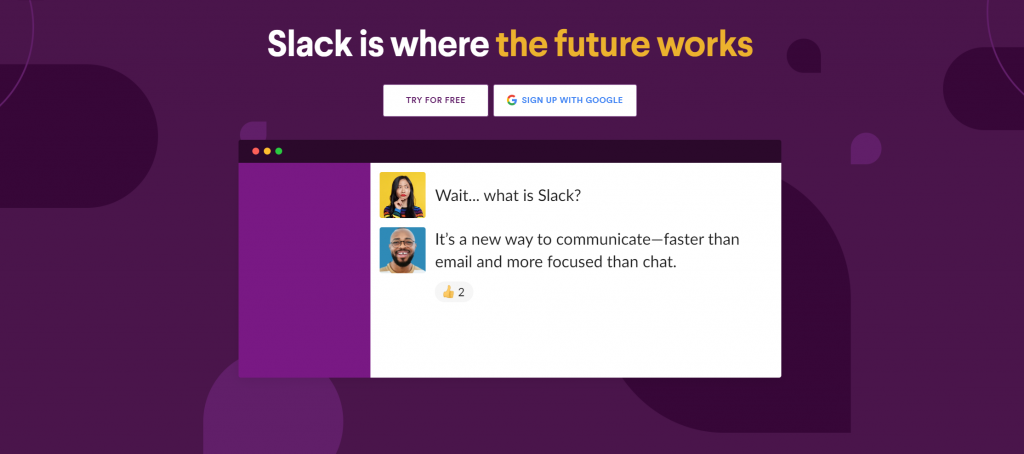
Slack is the virtual office for remote teams. Our team uses Slack religiously, using it for 90% of our communication.
With Slack you can direct message with other people in your team, and set up shared channels to chat about different departments, projects or topics.
More than 12 million people around the world use Slack, and for good reason. It’s a great tool for remote teams, it’s a brilliant way for virtual teams to stay connected, and for many teams, the free version is more than enough.
If you need more, it’s pretty affordable, or you can just use one of many third-party apps to extend what you can do on Slack.
Best Things About Slack:
Learn more about Slack, and how to put it to use in your remote team, in these articles:
The biggest competitor to Slack out there is Microsoft Teams.
It serves a similar purpose, as a team collaboration and communication tool. You can chat, make calls and hold meetings on the platform, and you can integrate other tools your business uses.
MS Teams is available for free as well, though it’s generally used more in larger teams (compared to Slack), for whom the paid version may be necessary.
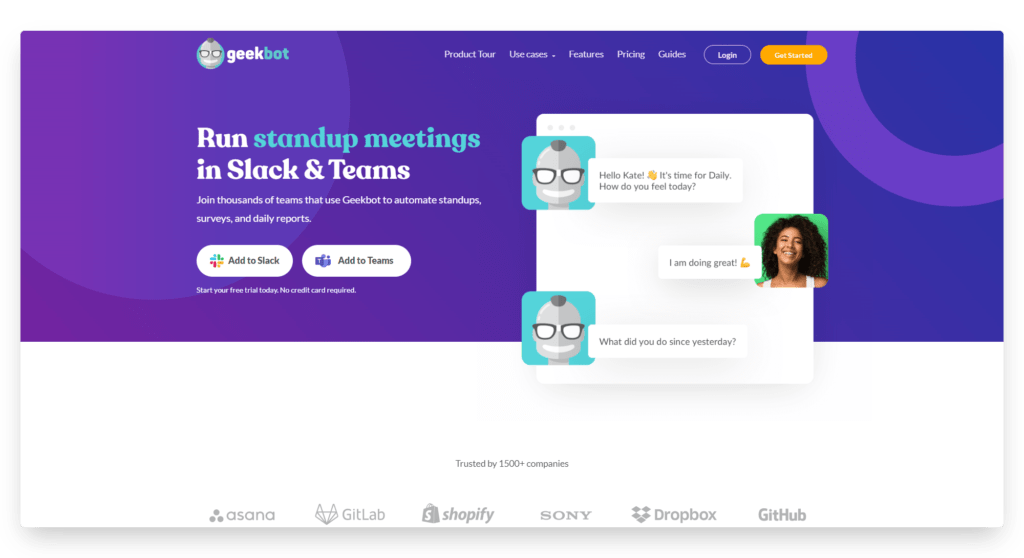
Geekbot is another communication tool we love. It’s a standup app for Slack and MS Teams. It’s a way to automate daily “standup” meetings, where team members give progress updates and updates on what they’re working on next.
Standups are an awesome way to keep everyone on the same page, and Geekbot makes this really easy, sending a private message to team members at the same time every day with several prompts (the prompts and timing you can customize, of course). Once filled out, it sends the report to a channel in your workspace.
We’d say standup meetings are a must as a remote team, and Geekbot helps you do standups as efficiently as possible.

Trello is one of the best and most popular way to manage projects for remote work. It uses a “kanban board” style, where tasks (or cards) are visualized in columns, usually indicating different stages, such as in progress or complete.
Trello’s free plan offers enough for most small businesses, with up to 10 boards for different projects, or different areas of your business. On top of that, Trello offers paid plans which will work better for larger scale businesses, and feature advanced tools like timeline, calendar and dashboard views and better access controls.
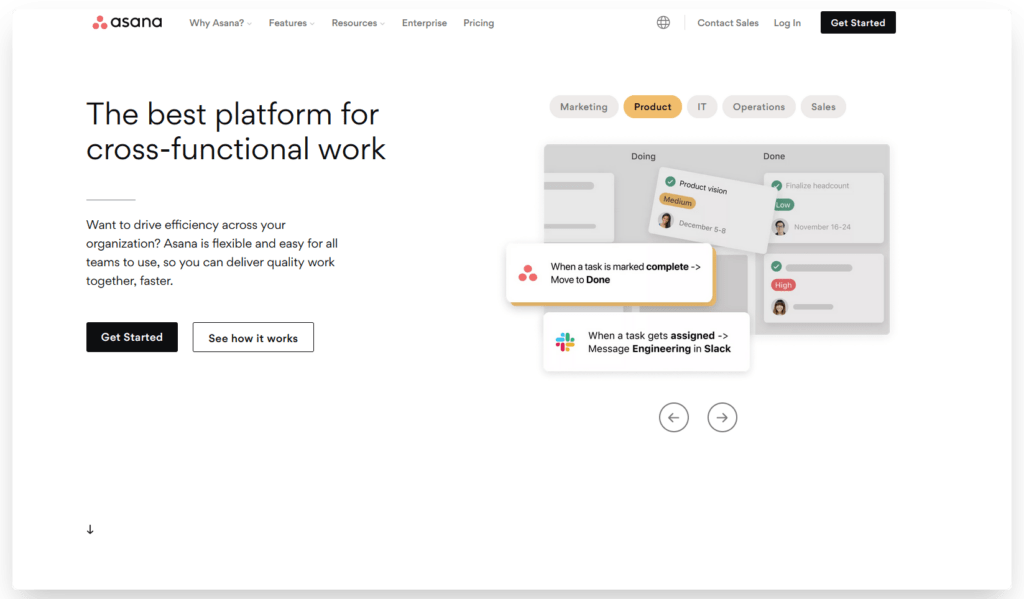
Asana is another task-based project management tool. You create cards for specific tasks, assign staff members to a task, and track progress and due dates (all features that are part of Trello as well).
The interface for Asana is not quite as simple as Trello, however it gives you a little more on its free plan than Trello does, particularly in terms of the different viewing options for your projects. You can toggle between a kanban board view, calendar or list – but you’ll have to pay for timeline view.
All up there’s not a lot to separate Trello and Asana. They do very similar things, and which one you choose for your business is down to which interface you feel most comfortable with.
Monday is another solid task management tool. Over 100,000 organizations use Monday, due in a large part to its visually striking interface and the amount of customization that’s possible.
This tool is particularly effective at tracking task and project status, with its effective and customizable color coding system. It also does workload management, which is great for visualizing how much each team member currently has on their plate, and avoiding burnout or overwork.
Many of Monday’s most powerful features are limited to their paid plans, but they do offer a free plan as well, that will suit small teams or individuals (such as freelancers) looking to organize their personal workflow.
There are thousands of other remote project management tools out there, and we won’t mention all of them. But one more that’s worth including is Basecamp.
Basecamp helps you organize everything to do with a project, team or department in one place. This includes scheduling, messaging, file storage, task tracking, to-dos, and more.
You can even integrate other tools with Basecamp, such as integrating Help Scout to create tasks for new support tickets.
It’s powerful, but a little expensive, compared to tools like Trello and Asana. Still, there’s a free trial for you to test it and see if it’s worth the price tag.

We use Google Workspace for so many things, it’s insane that it’s basically free.
If you want to set up a business account, with business emails for each user, it does cost. But you can use all the Google Workspace tools on a free account.
It’s got a spreadsheet tool (Google Sheets), a word processor (Google Docs), a presentation tool (Google Slides), and more, including Google Forms, Meet and Calendar – alongside the ubiquitous Gmail.
All these tools are perfect for remote team collaboration. You can create shared docs or sheets which other team members can comment on or edit, you can hold team meetings in Google Meet, and run your schedule on Google Calendar.
If you include all these tools under one banner, it’s hard to argue against Google Workspace as the most powerful remote working tool that exists today.

One area that Google Workspace doesn’t cover is collaborative design projects. That’s where Figma comes in.
Figma is a great design tool that’s perfect for remote teams. It’s collaborative by nature, with the ability to share projects for fellow team members to add to or give feedback. It’s perfect for website and app design, particularly when you’ve got multiple parties involved in the project, such as project managers, designers, copywriters and programmers.
One more tool for collaboration on creative projects is Adobe Creative Cloud.
To be fair, this is much more than just one tool. The apps offered by Adobe cover a range of uses for a range of different types of projects, including Premiere Pro for video production and Photoshop for graphic design.
With Adobe you get creative tools recognized as the best by industry professionals, with a cloud-based platform that allows you to provide access to different team members all across the globe.
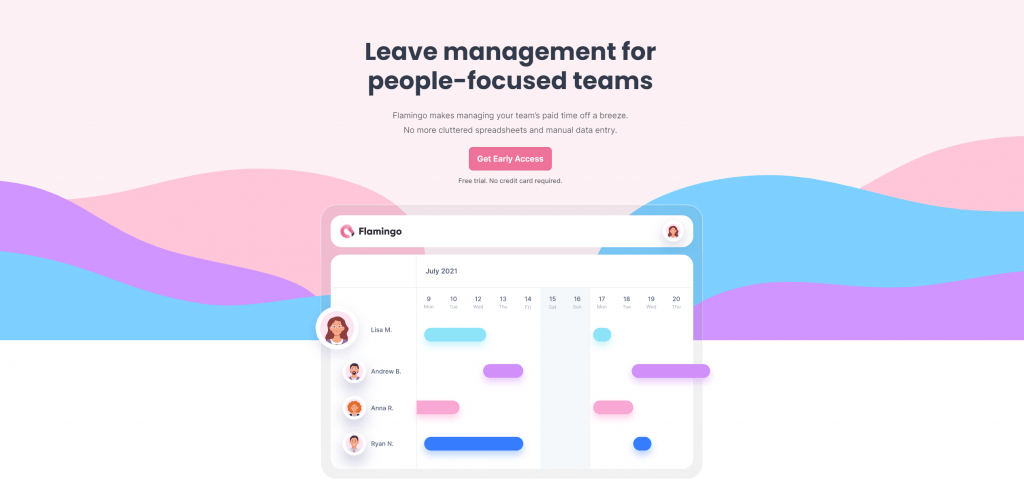
Distributed teams need a streamlined leave management system, to make it easy to manage when employees take time off. And our software, Flamingo, is the best tool for the job.
We built it using our experience as a remote team, knowing just what remote teams need from a leave tracking app. It’s made to fit seamlessly into your existing workflow (by integrating with apps like Slack/Google Calendar), and massively cuts down the time you’ll spend handling time off requests and keeping your vacation calendar up to date.
An app like Flamingo gives remote teams the peace of mind to be able provide their employees with ample paid time off, boosting work-life balance, employee engagement and retention, without letting it interfere with productivity.
It’s fast and easy to set up, and comes with a free trial to let you see how it will make your life easier, risk-free.
Flamingo streamlines leave management, letting you spend less time managing paid time off and more time growing your business
Notion is an incredible organizational tool, which remote teams can use to manage and store all their important documents.
You can use it to create things like SOPs, org charts, onboarding documentation, compliance information, your employee handbook, company policies and more.
This is invaluable for the human resources side of the business. There are a ton of templates available to help you set up your team’s Notion, and then once underway, it’s incredibly flexible to let you craft it how your team needs it to work.
Larger remote teams need a lot of record-keeping and reporting, which traditionally involves paper records and physical files. Bamboo HR takes all of that and makes it digital.
Bamboo HR is a full-stack HR tool, which makes it easier to manage a large team with remote employees. It has solutions for everything from hiring and onboarding, to vacation tracking, to performance management, to payroll and tax management.

Zoom is probably the first word that comes to mind when you think about online calls or meetings. This tool exploded in popularity with the pandemic forcing social distancing, and is now the 16th largest website in the world, and 6th largest in the USA (as per alexa.com’s rankings).
It’s popular because it’s simple and easy to use. Anyone can set up a call, which other people can join via desktop or mobile. You can make video calls, audio calls, conference calls and share your screen during calls. All of this is free.
Zoom’s pro plans give you access to larger and longer meeting rooms, call recording, and advanced features like transcription.
Google Meet is a more simplified version of Zoom. It works in the browser, and you can set up a call with just a Google account.
Video calls and group calls are free. There are limits to free calls – 24 hour duration for a single 1 to 1 call (which should be more than enough), 60 minutes for a group call, and a maximum of 100 participants for group calls.
The only restriction that may cause problems for business use is the 60 minute limit on group calls. However, this is extended to 24 hours for Google Workspace subscribers. Your business may already be using this – for company branded email addresses, for example – in which case Google Meet should be more than enough for the needs of almost all small to medium businesses.
While Zoom and Google Meet have exploded in popularity in recent times, Skype has been around much longer as a solution for online calls and meetings. Microsoft’s Skype allows you to host person to person calls and group calls, as the previous tools do.
Skype has lost ground over recent years to these competitors, as there is a little more friction involved in setting up calls – you need to sign in with a Microsoft account, and it takes longer to just set up a call than with Google Meet or Zoom. However, if Microsoft accounts are already a part of your business workflow, Slack may work fine for your online meetings and one-on-ones.

It can be difficult to find the perfect environment for calls or meetings when working remotely. There’s always a kid yelling in the background, loud keystrokes, poorly timed construction, or many other things that get in the way.
Krisp helps with this. It eliminates background noise in calls and voice recordings, integrating with a huge range of video call/meeting tools. It’s perfect to use for meetings, client calls, Loom videos, marketing videos, or anything else where you can’t afford have background noise get in the way.
If you have remote employees in loud, exotic locations (we have several in Vietnam – so we know), Krisp might prove to be one of the most valuable remote work tools on this list.
Veed is a video editing, recording and streaming tool, with features such as a video trimmer, which can be used a number of ways in remote teams. You can make screen recordings to share internally or externally, record a podcast, run live or asynchronous meetings, and allow team members to comment on videos to enable everyone to participate, even if they aren’t able to join live.
Veed’s video editing tool is also perfect for creating sales or marketing content for your brand, making it a great all-round tool for remote teams.
Loom is one of the most popular screen recording tools today. It’s an easy way to communicate with other members of your team, when a written message just doesn’t cut it.
You can record your screen, record voice over the screen recording, and share it for your team or specific people to watch. It’s the next best thing to being in the same room with somebody.
Loom is free to use, which makes it perfect for when you need to record a quick throwaway screen share. If you want to level up your videos and get access to unlimited recording length, custom branding and a drawing tool, Loom Business is a great option for a small monthly fee.
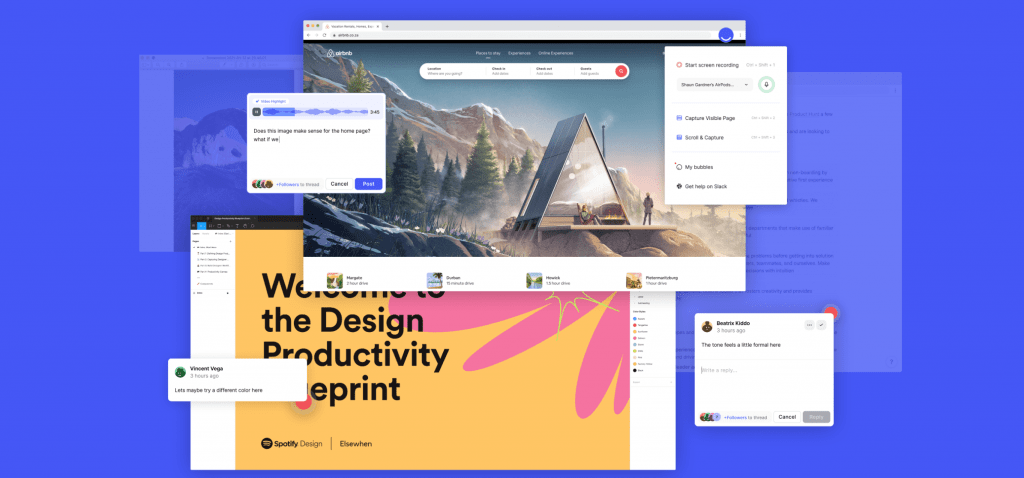
Bubbles is a tool that does everything – screen recording and image screenshots – and it’s free. The best thing is, it’s made by a remote team, specifically as a remote work tool to assist with asynchronous communication.
The process with Bubbles is simple. Install the chrome extension, then hit the icon whenever you want to take a snapshot or record your screen. Straight away you’ll get a link to share your image or video, and people you share it with can comment. It makes discussing things with your team super easy and straightforward, cutting down a lot of the time taken in the collaboration process.
Dropbox has been one of the most popular cloud storage tools – gaining success even before cloud storage was so common.
The best part about Dropbox is how simple it is. It’s not at all complicated to use – just save your files to Dropbox, organize with folders, and share them with your team. This simplicity means it’s super fast, which will help greatly with your workflow.
Dropbox starts with 2 GB of storage on its free plan, and offers several premium plans for higher storage limits and more advanced sharing functionality.
Google Drive is a super convenient solution for storing and managing shared files. You can create folders to organize your business’ files, giving shared access to specific people. This lets your whole team access important files such as documents, photos, videos, spreadsheets and more. It’s super simple to view, edit and download files straight from Google Drive, and it comes as part of any Google account.
Backblaze is a great way to ensure you never lose important work or documents due to software or hardware issues.
It’s both a cloud storage and automatic backup tool. You can manually store important files in the cloud, or set it up to automatically back up your machine, and restore them at any time. It works for Mac and Windows, and gives immense peace of mind for companies with remote workers scattered in multiple locations.
Unsecure networks can be dangerous. If your employees are working from public connections, such as coffee shops or airports, and their work involves sending and receiving important information, you’ll probably want them using a VPN.
A VPN (Virtual Private Network) encrypts your network, making it harder for people to view your activity and intercept your data.
NordVPN is my pick here – but, like with password managers, there are many more options that work just as well, including ExpressVPN, Surfshark and Private Internet Access.
Secure passwords are the first step of a secure system. You want your team to have complex, unique passwords for each login. For that, you need a password manager. 1Password is a powerful and secure password manager, which also allows you to store documents like backup phrases and security questions.
There are many more password managers out there that work just as well – such as BitWarden or LastPass. Just make it a habit to use one of these to create and store login information.
You’ll also want to use 2FA (2 Factor Authentication) wherever possible, for another line of defense for your logins. Google Authenticator is a simple and free 2FA solution that works better than text verification, particularly for remote teams, where employees are often traveling around different countries and text messaging may not be reliable.
Finally, you’ll want to equip your distributed team with antivirus software as another layer of protection. While safe internet practices can prevent many security issues, it’s important as well to protect work devices with a malware scanner to prevent problems ranging from adware that reduces performance, to malicious ransomware and viruses.
One of the biggest antivirus softwares out there, Avast has varying levels of business plans, depending on the level of protection you need and the number of devices. The yearly cost of a license is significantly less than that of dealing with a vulnerability or attack after it has happened.
If you have remote workers handling sensitive information, an encryption tool is a must. It’s just too easy to lose a laptop or phone, or have it stolen, and for sensitive data to fall into the wrong hands.
7ZIp is one tool you can use to compress and encrypt files, so that they can only be accessed with a password. Alternatively, Windows’ BitLocker and Mac’s FileVault allow full disc encryption if you have a lot of sensitive files you need to protect.
Clockify is a simple and free time tracker. It gives you a timer to turn on or off to track total working time, and clean reporting to track things like billable hours or overtime. It’s useful for individuals or freelancers, for managers to keep track of their employees, or to view trends to improve time management and productivity.
Time Doctor is another powerful time tracking tool, which offers a number of customizable features based on what you need for your business. It includes attendance tracking, payroll and billing integration, automated screenshots, web and app usage reports and popup warnings to keep staff on track.
It’s one of the best options out there should you need to manage and monitor VAs, or other remote employees who perform time-based work.
Toggl is another time tracking tool, great for remote teams, freelancers and all kinds of remote workers.
It’s flexible and versatile. You can use Toggl to track billable hours, timesheets, team productivity, or even use it for personal use to see where you’re spending your time.
Staying on the personal productivity path, staying focused can be a real struggle with remote work.
The “Pomodoro” technique is a proven way to maintain focus and productivity, and get more done. It involves working for 25 minutes, followed by a 5 minute break, and repeating. It’s very simple, but it works.
There are many apps out there that you can use to time this – Pomodor is one. It’s free, customizable, and tracks your stats so you can look back later and feel great about how productive you’ve been.
To-do lists are a great way for remote workers to be more productive. You want to break up projects into smaller tasks, track these in order of importance, and check them off throughout the day.
Nirvana is a great way to track projects and tasks individually. You can prioritize your to-dos, break them up into different projects or categories, add due dates, and more. I don’t go a working day without opening Nirvana – though you may find other to-do list apps out there that work just as well for you.
Related: how to create a To-Do List in Slack
With so many remote work tools in your toolkit, you might find it gets too complex switching between them all.
In that case, Zapier can be a huge help. It lets you set up automations, for repetitive tasks, or to have different apps work together. This helps you build a streamlined workflow, which allows you to get more done.
A great note-taking app like Evernote is another remote work must. Evernote makes it simple to quickly record to-dos, thoughts, and things to revisit. You can sync notes across all your devices, as well as share them with other team members.
For hybrid workplaces, employers may need to access their office computer while they’re working from home. TeamViewer is a great tool to do it, allowing remote access to any device, with enterprise-grade security and stability.
A remote work tool like CallHippo is essential for remote teams where phone calls are a key part of their operation.
It’s great for sales teams, customer service teams and call centers. With CallHippo, all these teams can do their job remotely.
CallHippo provides virtual phone numbers for hundreds of countries, call recording, analytics and much more. It’s a great way to set up a fully virtual phone system without sacrificing anything in productivity or customer service.
Remote team management is hard. So is remote work itself. Luckily, there is a huge industry of tools out there to help make remote working easier.
Remote work tools, such as collaboration tools, project management tools and video conferencing tools, are all essential if you want to run an effective and efficient remote team. There are just too many barriers to remote work if you don’t make smart use of software.
In our team, we currently use:
I personally have used almost all of these tools, and currently use tools like Nirvana, Evernote, Notion and Pomodor for personal productivity.
Go through our list and choose the tools that you think best fit your business, or your own workflow if you’re working remotely.
Flamingo® makes managing your team’s paid time off a breeze.